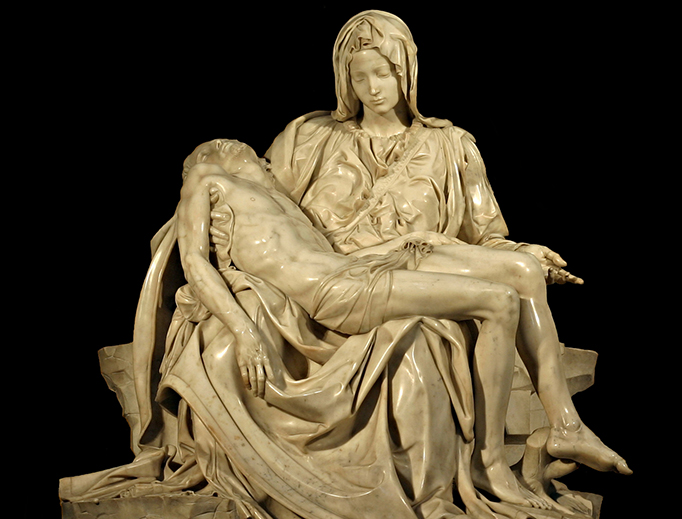The Great Michelangelo Was Fra Angelico’s Heir, But God’s First
We need only to gaze upon the Pietà, the Sistine Chapel and St. Peter’s Basilica to see that he inherently understood the mission of salvation.

What are we to make of Michelangelo Buonarroti? Was he a man of true faith, or was he given over to the sins that marred his time? After all, it was the age of the Renaissance, when Europe basked in its newfound identity of licentiousness and poetic expression, shaking off the morose characterization of the Middle Ages. Artists like Michelangelo were in great demand by their wealthy patrons to visualize this rebirth of classical antiquity, concupiscence and sensuality.
Exactly 460 years have passed since Michelangelo died at nearly 89 years of age on Feb. 18, 1564. There was no doubt he was Catholic, a Florentine man forever, but to what extent did he imbue his life with the faith he so brilliantly expressed in his art? While he was a Third Order Franciscan and a daily communicant, questions still linger about how seriously he took the faith in which he was born and the faith that inspired his work. Rumors of his rampant homosexuality, for instance, persist to this day — but there is no evidence of such behavior.
And yet perhaps the best answer might be not with words, but looking at three works of art produced by Michelangelo himself. Their strategic places in the heart of western Christendom — Rome, namely, the Vatican itself — emphasize Michelangelo’s prominence in the Catholic Church. It might be more prudent to say, rather, that it is not an emphasis so much on Michelangelo the man, but the artistic works themselves and the theology and emotion they express that are given prominence in the Church. They are the Sistine Chapel, the Pietà and the dome of St. Peter’s Basilica.

Each of these works was undertaken at different times in Michelangelo’s career. He completed the Pietà, that marble sculpture that has melted so many contemplative hearts, at age 23. The depth of sorrow and compassion conveyed in the Pietà belies the artist’s youth. Yet, as a great artist is wont, Michelangelo’s complexity and artistic ambition deepened with time; he became fixated on death the longer he lived. And like a great artist, he channeled his inner conflicts into his art.
By the time Pope Julius II, one of many papal father figures in Michelangelo’s life, commissioned him to paint the ceiling of the Sistine Chapel, Michelangelo was now in his mid-30s. The project took four years, consuming a great amount of physical and mental energy. The treasure given to us, however, is a visual Bible, scenes packed with eye-popping art that is all the more beautiful because of Michelangelo’s singular ability to convey profound theological concepts and meanings with no words. There is no need for further explanation of what is presented on the ceiling of the Sistine Chapel. The fall of man and his redemption are depicted for our contemplation — they are beyond words.
Still more time passed before Michelangelo returned to the Sistine Chapel: nearly 25 years later, Michelangelo embarked on the thunderous, haunting, ineffable Last Judgment. Michelangelo was now in his early 60s. And yet he toiled for the next six years producing an iconic masterpiece. Juxtaposed with what he achieved as a younger man with the Sistine Chapel ceiling, perhaps Michelangelo felt constricted or stymied by the looming masterpiece of God the Father reaching out towards the laconic Adam.
But the Last Judgment is not simply a remake of the work on the ceiling, but something more urgent, terrifying — death, he knew, was nearer than ever. What might become of his own fate, he might have thought? Or the fate of a humanity redeemed by the Savior’s death and resurrection, but a humanity seemingly disinterested in abiding by the Savior’s invitation to “Come, follow me.” Michelangelo could have taken any other assignment, but he gave so many years, so much talent over to the Church. He was an artist with no real education, certainly no formal theological training, but one who inherently understood the mission of salvation.
Finally, and perhaps most incredibly, Michelangelo was called into papal service one final time at the age of 70. It was 1547. For decades, construction on the new St. Peter’s languished. Architect replaced architect. And yet, the church that was supposed to define the Church sat in utter ruins half-built, half-demolished, as the original basilica from Constantinian days was gradually dismantled. Someone needed to right the excess, to both appease and challenge the Fabbrica — the governing body of the basilica — and to somehow make it all beautiful at the same time. Though he considered himself a sculptor first, Michelangelo never saw himself as a real painter and certainly not an architect. But given the confidence and tools, Michelangelo produced brilliance once again. The dome of St. Peter’s, recognized the world over, is Michelangelo’s final and perhaps most impressive accomplishment.
He retained the title of Supreme Architect of St. Peter’s Basilica for 17 years, right up until his death.
The Christian faithful can thank Michelangelo for reshaping, inspiring and challenging how Christian tradition is expressed and viewed from an artistic lens. But such treasures were not bequeathed without toil, without flashes of doubt. And in those moments of a soul’s dark night, when one might expect an artistic temperament to carom out of control, Michelangelo only contemplated him who hung on the Cross. It was as simple, and as profound, as that.
What are we to make of Michelangelo? We need only to gaze upon what he has left us — the Pietà, the Sistine Chapel and St. Peter’s Basilica — to know that such art was not ultimately about the artist, but instead the Creator of all.















